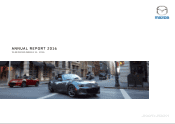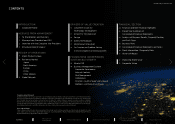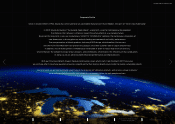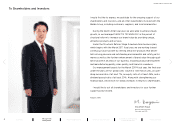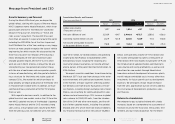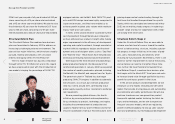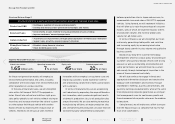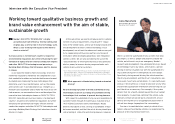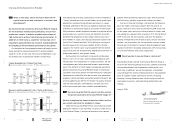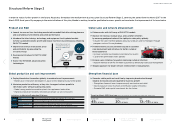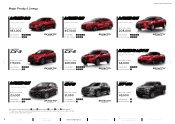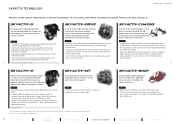Mazda 2016 Annual Report Download - page 9
Download and view the complete annual report
Please find page 9 of the 2016 Mazda annual report below. You can navigate through the pages in the report by either clicking on the pages listed below, or by using the keyword search tool below to find specific information within the annual report.
Q3 What is your basic policy and future direction for
capital investment and investment in research and
development?
During the period covered by Structural Reform Stage 2,
we will maximize manufacturing efficiency at our main
production centers to achieve a global sales volume of
1.65 million units without constructing new factories. In
addition, to meet various countries’ increasingly strict
regulations going forward, our research and development
will emphasize environmental performance and safety.
Our baseline for the aggregate amount of capital invest-
ment during the period covered by Structural Reform
Stage 2 is 3.5% of net sales. We will also implement a vari-
ety of measures at production centers to maximize
manufacturing efficiency. Specifically, we will strengthen a
“swing” production structure that allows for mutually com-
plementary manufacturing between our plants in Japan,
Thailand, and Mexico. We will also enhance manufacturing
efficiency by maximizing capacity utilization at each plant.
With crossover models expected to grow as a portion of the
overall sales mix, we will increase our flexibility to switch
between the production of passenger vehicles and cross-
over models in Japan, and step up production capacity for
the CX-3 in Thailand and the CX-5 in Malaysia, raising pro-
duction capacity for crossover models to 50% of total
capacity. For further sales volume growth from the March
2020 fiscal year, we will determine additional investment in
production capacity with proper timing.
Our baseline for investment in research and develop-
ment is 4.0% of net sales, and including compliance with
increasingly strict regulations in various countries, we are
strengthening our future-oriented research and develop-
ment. The SKYACTIV GEN2 models introduced during the
period covered by Structural Reform Stage 2 will provide
customers with even greater environmental and safety per-
formance and
Jinba-ittai
than our current new-generation
products, which are highly acclaimed around the world. We
are also updating our SKYACTIV models to quickly incorpo-
rate the latest designs, technologies, and features in an
effort to increase both sales volumes and profitability.
Q4 How will you prioritize the use of cash flow during
the period covered by Structural Reform Stage 2?
We will strengthen the financial base for stable, continu-
ous growth and raise the dividend in stages.
Under the Structural Reform Plan, we achieved a certain
degree of stability in our earnings structure. Under Struc-
tural Reform Stage 2, we plan to maintain sales volume
growth while promoting right-price sales and increasing
cost efficiency globally to generate stable cash flows.
Our basic financial strategy is to build up the financial
base for stable, continuous growth with the aim of an
equity ratio of at least 45% by the March 2019 fiscal year.
At the same time, we will raise the dividend in stages and
are aiming for a payout ratio of at least 20% by the March
2019 fiscal year. We will carefully consider the balance
among strengthening the financial base, returns to share-
holders, and investment for future growth, and we intend
to raise our investment in research and development and
capital investment, including compliance with increasingly
strict environmental and safety regulations.
Q5 Would you like to say anything in conclusion?
During the period covered by Structural Reform Stage 2,
we will work toward qualitative business growth and brand
value enhancement and to generate stable profits and
cash flow. In addition, we aim to maximize shareholder
value through the further enhancement of a management
base to support stable, continuous growth, including
building a strong financial base, diversifying and cultivat-
ing human resources, and promoting prompt decision
making.
August 2016
Interview with the Executive Vice President
Akira Marumoto
Representative Director and
Executive Vice President
Capital Expenditures / Ratio of Net Sales
■Capital Expenditures (Billions of yen) Ratio of Net Sales (%)
(Forecast)
3.8 4.9
3.5 4.3 3.2
2.6
78.0
2012 2013 2014 20162015 2017
77.2
133.2 131.0
89.2 105.0
Years ende
d
March 31
Research and Development Costs / Ratio of Net Sales
■Research and Development Costs (Billions of yen) Ratio of Net Sales (%)
4.5 3.7
4.1 3.6 3.8
3.4
91.7
2012 2013 2014 20162015 2017
89.9 99.4 108.4 116.6 125.0
(Forecast)
Year nde
rch 3
MAZDA ANNUAL REPORT 2016
7Message from
Management
Review of Operations
Drivers of Value Creation
Foundations Underpinning
Sustainable Growth
Financial Section
Contents

